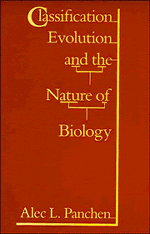Book contents
- Frontmatter
- Contents
- Acknowledgements
- CHAPTER 1 INTRODUCTION
- CHAPTER 2 PATTERNS OF CLASSIFICATION
- CHAPTER 3 PATTERNS OF PHYLOGENY
- CHAPTER 4 HOMOLOGY AND THE EVIDENCE FOR EVOLUTION
- CHAPTER 5 GEOLOGICAL AND GEOGRAPHICAL EVIDENCE
- CHAPTER 6 METHODS OF CLASSIFICATION: THE DEVELOPMENT OF TAXONOMY
- CHAPTER 7 METHODS OF CLASSIFICATION: PHENETICS AND CLADISTICS
- CHAPTER 8 METHODS OF CLASSIFICATION: THE CURRENT DEBATE
- CHAPTER 9 CLASSIFICATION AND THE RECONSTRUCION OF PHYLOGENY
- CHAPTER 10 IS SYSTEMATICS INDEPENDENT?
- CHAPTER 11 MECHANISMS OF EVOLUTION: DARWINSM AND ITS RIVALS
- CHAPTER 12 MECHANISMS OF EVOLUTION: THE SYNTHETIC THEORY
- CHAPTER 13 SCIENTIFIC KNOWLEDGE
- CHAPTER 14 PHILOSOPHY AND BIOLOGY
- References
- Author index
- Subject index
CHAPTER 7 - METHODS OF CLASSIFICATION: PHENETICS AND CLADISTICS
Published online by Cambridge University Press: 03 May 2011
- Frontmatter
- Contents
- Acknowledgements
- CHAPTER 1 INTRODUCTION
- CHAPTER 2 PATTERNS OF CLASSIFICATION
- CHAPTER 3 PATTERNS OF PHYLOGENY
- CHAPTER 4 HOMOLOGY AND THE EVIDENCE FOR EVOLUTION
- CHAPTER 5 GEOLOGICAL AND GEOGRAPHICAL EVIDENCE
- CHAPTER 6 METHODS OF CLASSIFICATION: THE DEVELOPMENT OF TAXONOMY
- CHAPTER 7 METHODS OF CLASSIFICATION: PHENETICS AND CLADISTICS
- CHAPTER 8 METHODS OF CLASSIFICATION: THE CURRENT DEBATE
- CHAPTER 9 CLASSIFICATION AND THE RECONSTRUCION OF PHYLOGENY
- CHAPTER 10 IS SYSTEMATICS INDEPENDENT?
- CHAPTER 11 MECHANISMS OF EVOLUTION: DARWINSM AND ITS RIVALS
- CHAPTER 12 MECHANISMS OF EVOLUTION: THE SYNTHETIC THEORY
- CHAPTER 13 SCIENTIFIC KNOWLEDGE
- CHAPTER 14 PHILOSOPHY AND BIOLOGY
- References
- Author index
- Subject index
Summary
We have seen in Chapter 6 and the previous chapters that dissatisfaction with traditional taxonomy gave rise, after the Second World War, to two distinct attempts at a remedy – phenetics and cladistics. In this chapter, I review the methodology of these two schools, as they were originally proposed and developed. In each case I describe the principles and methods, which I hope will be sufficiently clear to non-taxonomic readers to enable them to follow the subsequent discussion. In each case there has been an important development of the original philosophy and method. In the case of phenetics, various biochemical techniques have used phenetic methods, but also, and importantly, “numerical cladistics” has diverged from phenetics and converged on cladistics. In the case of cladistics, “transformed cladistics” is regarded by some as an offshoot and rival to mainstream cladistics and by others as a logical development of the mainstream. These will be dealt with in Chapters 8 and 9. In Chapter 10, I shall attempt to sum up the present state of taxonomy and to draw conclusions that I regard as pivotal to the theme of this book.
Phenetics
Pheneticists used to trace their history back to Adanson, a contemporary of Linnaeus (Sokal and Sneath 1963, p. 50).
- Type
- Chapter
- Information
- Classification, Evolution, and the Nature of Biology , pp. 132 - 168Publisher: Cambridge University PressPrint publication year: 1992

